The chefs reclaiming Lithuania's cuisine
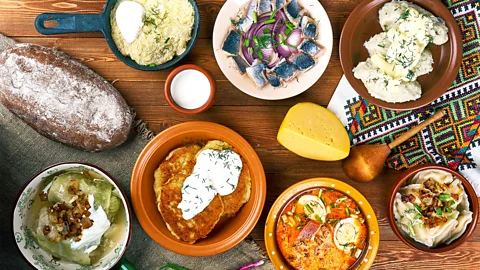 Alexander Mychko/Alamy
Alexander Mychko/AlamyWar and Soviet occupation robbed Lithuania of its unique culinary history. Fortunately, there is a growing number of chefs and cooks committed to ing it.
Imagine long strands of dill swimming in a cold, beetroot soup; soul-restoring potato dumplings with your choice of cottage cheese or meat on a freezing winter's day; fried black bread with garlic you vigorously rub onto the bread yourself. These are some of the staples of Lithuanian cuisine; hearty meat-and-potatoes fare to fill you up for the labour of the day.
They're all delicious, comforting and satisfying, but that's only scratching the surface of Lithuanian cooking. Tourists are forgiven for their ignorance since the tiny Baltic nation has yet, for better or worse, to tickle the imagination of travel and food media at large.
The tragedy of it all is: Lithuanians themselves can be just as unaware when it comes to their own culinary heritage. But there are a number of chefs committed to ing their historical national dishes and serving it up so that future generations can continue the long process of reclaiming their cuisine.
The fact that many Lithuanians are unfamiliar with the roots of their own cuisine was not by accident. Lithuania was occupied by the Soviet Union from 1940-1990.
"It is very important to bear in mind that during the Soviet occupation, Lithuanians for nearly 50 years did not have access to their own history," explained Nida Degutiene, author of the book A Taste of Israel: From classic Litvak to modern Israeli. (Litvak refers to Jews with roots in historical Lithuania.) "Our history was rewritten by Russians. Any religion – Catholic, Jewish – was forbidden."
Degutiene explained that baptisms, church marriages and celebrating Shabbat were all forbidden during the Soviet era.
"People were hiding their identities," she said. "We knew nearly nothing about the roots of our cuisine."
 Kyoko Uchida/Alamy
Kyoko Uchida/AlamyChef Rita Keršulytė-Ryčkova of Lokys in Vilnius puts it even more succinctly: "The internal policy of the Soviet Union, especially in the Baltic region, was to erase our identity and make us Soviet, not Lithuanian."
This meant spending more time on Russian language lessons than Lithuanian and ridding society of its intellectuals – applying the same approach to Lithuanian literature, culture, religion and gastronomy.
"There was a one-cuisine approach for our entire region without variation," Keršulytė-Ryčkova said. "There was a list of dishes that were made in all restaurants and cafes, and you could not do anything out of the list."
Keršulytė-Ryčkova said that a typical Soviet menu might include Chicken Kyiv (chicken fillet pounded, rolled in butter and coated with egg and breadcrumbs); shashlik (meat skewers); meatballs made from pork; goulash; and borscht.
Two or three generations of gastronomic knowledge were lost by the time Lithuania gained independence from the Soviet Union on 11 March 1990. Lithuanians had mistakenly conflated their historical cuisine with Soviet cuisine, and the knowledge of how to make traditional Lithuanian dishes was lost. But chefs like Keršulytė-Ryčkova are resurrecting it, creating menus that tell a national story many Lithuanians themselves aren't familiar with.
But where does this story begin?
In Lithuania, there's a community of Romuva who continue to practice their ancient traditions. They're some of the first who can recognise the ancient roots behind how many Lithuanians eat and drink today.
A Romuva revival
In Lithuania, Romuva is making a comeback with approximately 10,000 and an ongoing fight for state recognition.
Ugnius Liogė, who organizes the community's annual Mėnuo Juodaragis festival, met me with Ignas Šatkauskas, a Romuva priest, at the snow-covered stone altar of Ragutis, the beer god of Lithuania's ancient faith. The medium-sized boulder sits behind an encased "eternal flame" next to the Russian Orthodox Church of St. Paraskeva in Vilnius's well-preserved Old Town neighbourhood where it's believed the original altar once stood.
Both Liogė and Šatkauskas discussed the violent period of Christianisation that occurred in the 14th Century, considered to be the most turbulent in Europe. For many Lithuanian history buffs, this bit of historical trivia is seen as a kind of humble brag that Lithuania held onto their native traditions longer than others in Europe. (Armenia was the first nation in the world to adopt Christianity in 301 CE followed by various European kingdoms between the 4th and 12th Centuries.)
Ultimately, however, Christianity became the dominant faith, but eating and drinking habits borne from this ancient tradition have remained, even if many Lithuanians don't know it. Kūčios, for example, is the traditional Christmas Eve (or Winter Solstice) dinner with some roots in ancient Romuva practice that Christians adapted to celebrate the birth of Christ. Although this practice was officially forbidden during the Soviet occupation, Catholic families continued to observe the tradition in secret.
Lithuanian historian Andželika Laužikienė explained some of the specific rules and traditions tied to Kūčios. For example, there are 12 dishes that represent the 12 apostles. These contain no meat, milk products or eggs because it's a strict fasting period.
"One has to taste at least a piece of every dish," she said, "for prosperity in the next year."
Laužikienė added that Lithuanians draw straws of hay from underneath a piece of cloth to see if they're going to live long – a tradition with strong roots in the Romuva faith.
Then there's raguolis, a traditional Lithuanian tree cake served on special occasions, particularly Christian holidays, like Christmas Eve and Easter. It's a large cake with hollow rings that look like horns. "Ragai" means "horns" in Lithuanian, and it harks back to the ancient God, Ragutis.
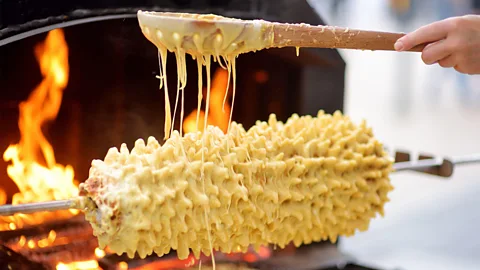 MNStudio/Alamy
MNStudio/AlamyThese are just a handful of the ancient Romuva traditions that live on. You'd never know where they came from by observing with the naked eye given the way they're constantly recycling and taking new forms. Nevertheless, they remain.
None of this is to say that all of Lithuania's culinary heritage stems from ancient or medieval times. There were centuries between the Christianisation of the country and Soviet occupation. And with that period of relative freedom, there's plenty for contemporary chefs to rediscover.
According to Keršulytė-Ryčkova's research, Lithuanian-written recipes did not exist before the 19th Century. And thus, she works with historical references to dishes and ingredients found in archives and old books, recreating them based solely on their description.
"We worked with the Lithuanian History Institute, and we looked into the inventories of different palaces," she said. "So, you have ingredients listed for each century, for each period, for each duke."
It was a busy Tuesday night when Keršulytė-Ryčkova led me down the spiralling stone staircase into the 16th-Century Gothic cellar where an entire portion of the menu features wild game with captions referencing the history.
Wild boar, for example, was a privilege reserved for Lithuanian nobles. Only they were permitted to hunt. Commoners, on the other hand, risked a death sentence if caught hunting. Now, for the price of €21, anyone can have a boar roast the likes of which Grand Duke Gediminas (1275-1341) would've enjoyed, served with cowberry wine sauce, and sweet pear and potato croquettes with cheese. There's also a beaver meat stew with mushrooms, tomatoes and a potato puree flavoured with spinach.
But what truly grabbed my attention, left my stomach grumbling and piqued my curiosity was the section of vegetarian and vegan dishes devoted exclusively to dishes with roots in Litvak cuisine: homemade boletus (a kind of mushroom) dumplings served with onion jam, cheese curd balls stewed in a tomato sauce; and zeppelins (a large potato dumpling also referred to as cepelinai) served with sour cream. This Litvak vegetarian section is a relatively new addition to the menu.
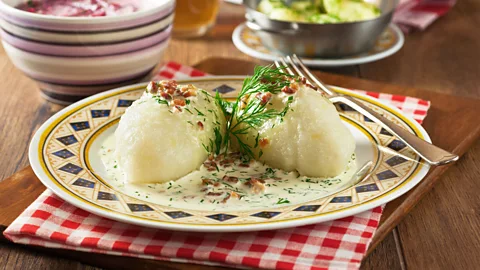 Simon Reddy/Alamy
Simon Reddy/AlamyKeršulytė-Ryčkova explained that a Jewish-American man whose parents were Litvaks from Vilnius visited and quickly became upset after looking through the menu. Lokys promised a recreation of historical Lithuanian cuisine and he couldn't find any representation of his ancestors. Keršulytė called the interaction an eye-opening, moving experience. She itted her mistake and promised him that the next time he came, she would have a dish on the menu that represented his history.
While not making excuses, Keršulytė-Ryčkova explained that this, too, is common in Lithuania. The guilt of the Holocaust, she surmised, is probably why.
"We missed a big part of Lithuanian history, because in Lithuania, we do not talk about our Jewish community that used to live here," she explained. "We know it, but it's not a subject we touch a lot commonly."
To fill the Litvak gap, she referred largely to Vilnius' own Fania Lewando, who wrote The Vilna Vegetarian, first published in Yiddish in 1938 and rediscovered and translated into English in 2015. The kosher caterer and author championed vegetarian cuisine long before it was en vogue and climate change demanded a tougher look at our eating norms. Her work drew inspiration from Jewish values that discourage causing animals undue pain and continues to inspire a new generation of Jewish vegetarian cooks. Keršulytė-Ryčkova based her curd cheese balls in tomato sauce on a mix of recipes from Lewando's book, such as the canned tomato soup, stewed potatoes with tomatoes, Ukrainian cheese varenikes (pierogis) and cheese dumplings with breadcrumbs. The kneidlach (matzo balls) came to her from Nida Degutiene's recipe in A Taste of Israel.
A cylindrical dumpling
The term "potato dumpling" is a catch-all English translation of a wide variety of potato dishes in European cuisine. In Vilnius, it'll get you a cepelinai or zeppelin – large dumplings made from grated raw potatoes and shaped by hand into the round, cylinder shape of a zeppelin. They're more glutinous than gnocchi and a closer cousin to the German or Austrian Kartoffel Knödel. It's soft and spongy with a generous dollop of dill-infused sour cream surrounding it like a castle moat.
Keršulytė explained that the Litvak dishes on her menu are so inextricably intertwined with non-Jewish Lithuanian culture, that they've adapted them for Christian traditions. The boletus or mushroom-stuffed dumplings are a Christmas Eve tradition.
"We also eat latkes, the potato pancakes that come from Litvak heritage," she said.
This blending of cuisines likely happened when Lithuanian girls would work at Jewish tavernas and learn to cook, bringing new recipes back home with them. Keršulytė-Ryčkova said this is how cepelinai entered and became the showpiece of Lithuania's culinary canon. They're easy to make, filling and nourishing. Non-Jewish Lithuanians merely adapted it by adding pork.
Most Lithuanians would point to cepelinai as one of the staples of their cuisine along with other potato-rich dishes, like kugelis – oven-baked grated potatoes mixed with onions, milk, eggs, salt, pepper and bacon. But Keršulytė-Ryčkova said they're actually from Vilnius' historical Litvak community dating to the beginning of the 17th Century.
"It's a very funny thing, because if you ask any Lithuanian on the street, he will swear that it's 100% Lithuanian and that it has nothing to do with the Jewish community," she said. "But it did come from their Litvak cuisine to us."
Fortunately, Lokys isn't the only restaurant where Litvak cuisine lives on. There's Beigelių krautuvėlė (simply "bagel shop" in English) opened by cookbook author Dovilė Rūkaitė in 2016. Inside there's a counter surrounded by the various caffeine-pumping apparatuses of a coffee shop and a bakery display with bagels, guoninė pynė (poppy seed rolls) and four golden bialys (like bagels but baked with a depressed centre filled with onion and poppyseeds). There were also teiglach (fist-sized, knotted pastries) on the counter.
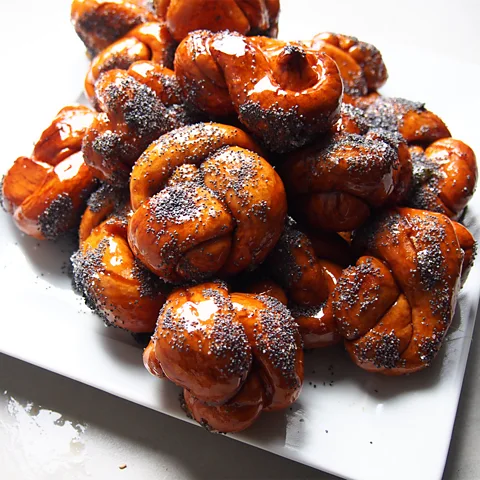 Beigelių krautuvėlė
Beigelių krautuvėlėAt dinner the night before, my cousin, Lina Daniene, who grew up in Vilnius absorbed by the Soviet Union, struggled to recall names of traditional Yiddish foods like these and told me that she regretted not learning how to make them from her grandmother.
"I think I was not encouraged to do so by my grandparents who feared anti-Semitism," she said. "But maybe they simply did not see much value in ing down the traditions, and I was not too willing to learn. I don't know."
At Beigelių krautuvėlė the following day, I excitedly snapped a photo of the honey-coated teiglach with orange zest, and a surprising blast of ginger, and sent it to her for confirmation.
"Wow!" she replied within minutes. "That's what I meant!"
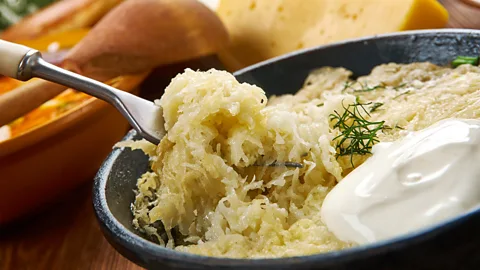 Zoonar GmbH/Alamy
Zoonar GmbH/AlamyDegutiene said that it took leaving Lithuania in 2009 for Israel to learn that many dishes (like latkes, challah, blintzes and honey cake) were, in fact, just as Jewish as they were Lithuanian.
"It honestly took time for me to acknowledge that, indeed, this has been our common culinary heritage," she said. Today, she thinks of Vilnius as one of the best places in the world to eat Jewish food.
These Jewish dishes are just one piece of the Lithuanian culinary pie. At Ertlio Namas, chef and co-founder Tomas Rimydis focuses on recreating Medieval, Renaissance and Baroque Lithuanian cuisine, interpreted with modern sensibilities in mind. Seasonality serves as the foundation of the restaurant as he relies on what's available in the garden, what he can hunt in the woods or fish in nearby rivers and lakes.
Rimydis its that the first two years of Ertlio Namas were difficult given the Covid-19 pandemic and their unconventional menu, at least in the eyes of Lithuanians.
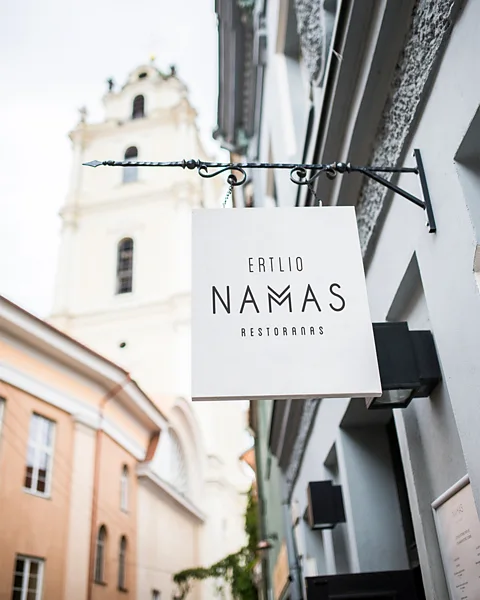 Ertlio Namas
Ertlio Namas"People didn't understand no potatoes and pork," he said.
They struggled with 20% occupancy in those early years, attracting almost exclusively tourists. Now, post-Covid lockdowns, Rimydis estimates that locals make up approximately 90% of their clientele with 100% occupancy almost every night.
Dinner service is an event, housed in an intimately lit 17th-Century home with a curtain separating the entrance into the modestly sized dining area. The waiter pulls the curtain back like an usher granting you entrance into the theatre. The way waiters explain the history behind each dish feels like a moderately paced theatrical performance.
The dishes start in the 15th Century (beetroot bread with roasted sunflower seeds) and work their way up to the 19th Century (quince dessert with chocolate and bread ice cream). There's everything from wild game (for meat eaters) to beetroot soup, a puree of Jerusalem artichokes and the ever-popular honey cake inbetween. A vegetarian adaptation was easy, considering the extra fasting (from meat) that Lithuanian dukes and nobles historically partook in. This, our waiter explained, was to prove to the Pope how serious they were about their Catholicism.
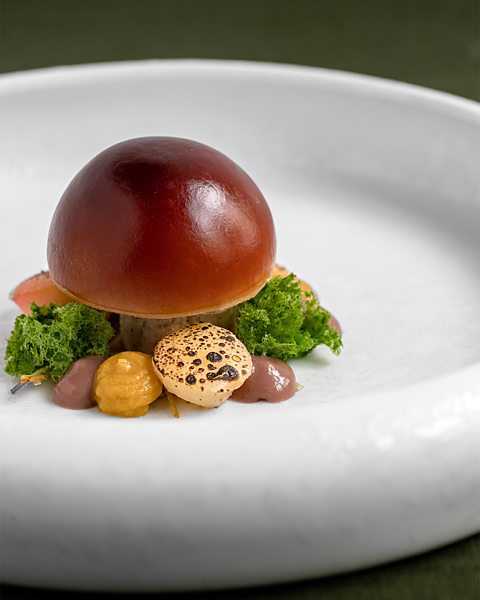 Ertlio Namas
Ertlio NamasA lesson on the contributions of Bona Sforza was a course unto itself. The Italian-born Duchess of Bari became the Queen of Poland and Grand Duchess of Lithuania in 1518 through her marriage to Krakow-born Sigismund I the Old. Our waiter explained that the queen was responsible for bringing 15th-Century Italian ingredients, such as tomatoes, cauliflower and artichokes, to the region in the days leading up to the Poland-Lithuanian commonwealth, forever leaving her mark on the cuisine – and therefore the menu at Ertlio Namas.
"If you come to Lithuania, you must come to Ertlio Namas," insisted Rimydis. "Then you can hear the history and really understand Lithuanian cuisine."
I travel often for food. Few experiences have drastically altered my conception of a national cuisine as my time in Vilnius. Don't let the facade of meat and potatoes fool you. The fare is as rich and complex as what most of us love about Italian, Japanese or French cuisine. These dishes are firmly rooted in their unique history: persistent ancient traditions, dukes with a taste for all things wild, Jewish resilience and other influences through the centuries.
 Lokys
LokysMatzo and cottage cheese balls recipe
By Rita Keršulytė-Ryčkova
Keršulytė-Ryčkova based this recipe on a combination of recipes from Fania Lewando and Nida Degutiene. It's got the tomato sauce brought over by Bona Sforza combined with the Litvak and Lithuanian love of dumplings in one dish.
Makes: 8-10 portions
Time: 1 hour, 25 minutes working time
Ingredients for matzo and cottage cheese balls:
500g cottage cheese
180g grated extra aged cheese (like parmesan, aged at least 24 months)
160g eggs
220g matzo meal
6g salt
3g black pepper
10g dried parsley
Ingredients for tomato sauce:
80g carrots, cut brunoise
30g celery stem, cut brunoise
500g chopped San Marzano tomatoes
Olive oil
Salt
Equipment:
1 oval-shaped porcelain gratin pan or baking dish that's approximately 8.7" long, 5.3" wide, and 1.8" deep (22cm long, 13.5cm wide, and 4.5cm deep)
Instructions
- Mix the ingredients for the matzo and cottage cheese balls together. Let the mix sit for at least 30 minutes.
- Form small balls with your hands of approximately 20g each.
- Sauté the vegetables for the tomato sauce with some olive oil and salt.
- When the tomatoes are cooked, the sauce through a sieve.
- Pour the tomato sauce into a small, oval-shaped porcelain gratin pan or baking dish and add the matzo balls into the sauce.
- Cook the matzo balls in the tomato sauce in the oven at 180C for approximately 22-25 minutes. They're finished when the matzo balls are firm and a bit browned on top.
- Serve with thin slices of extra-aged cheese on top.
BBC.com's World's Table "smashes the kitchen ceiling" by changing the way the world thinks about food, through the past, present and future.
---
more than three million BBC Travel fans by liking us on Facebook, or follow us on Twitter and Instagram.
If you liked this story, sign up for the weekly bbc.com features newsletter called "The Essential List". A handpicked selection of stories from BBC Future, Culture, Worklife and Travel, delivered to your inbox every Friday.
